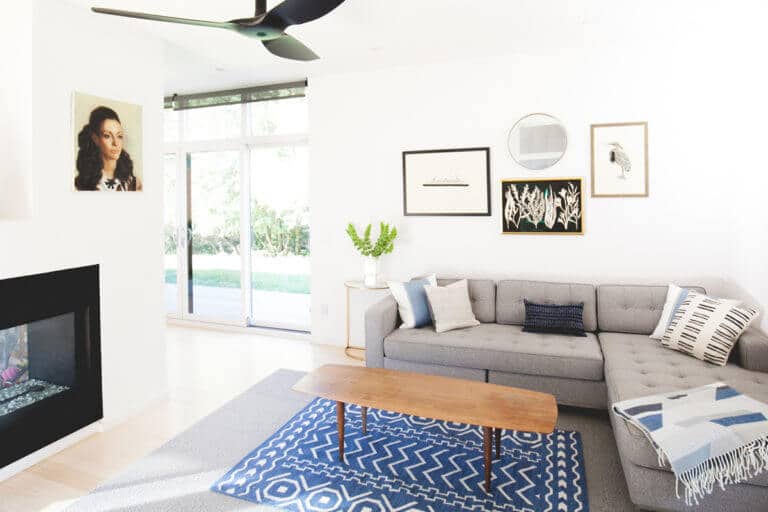Nervous About Layering Rugs? We’ll Help You Transition to Fall With a Few Tricks
It’s still warm outside, but it’s never too early to start preparing your home for fall. Because before you know it, there will be a chill in the air and you’ll be craving that cozy, layered look that makes you want to cuddle up in a room.
There are a number of time-tested ways to transition a room to autumn, whether it’s by introducing more texture in your throw pillows, or stacking thick blankets inside knit baskets that you can place around the room.
But we want to talk here about a more recent phenomenon, which looks great — and is absolutely perfect for fall — but can be a little trickier to master. This fall-transition trend we are focusing on? Layering rugs.
Why Layer?
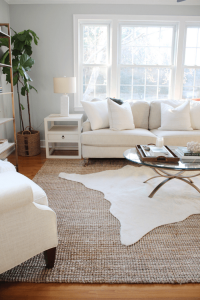
Now, all of you A-type personalities out there are probably groaning right now. I understand! When you first started seeing this design move, you likely found it a little distasteful. That little voice inside your head probably said, “What are they hiding? A spill?!?!?”
I’ll admit, it took awhile for me to warm to this trend as well.
But, and this is a big BUT, there are a lot of positives that come from layering rugs.
One, this technique allows you to firmly anchor a room — think about the impact you get from just one rug and then multiply that. Two, it adds visual interest and texture. Three, you can experiment with different looks with very little risk or extra cost involved.
Four…Do you need a four? Well, let’s be honest…layering can help you hide those stubborn stains on a well-worn but well-loved base rug.
So what do you have to lose? It’s at least worth trying for a season or two.
Don’t Be Afraid to Let Loose
I’ll acknowledge this upfront: layering rugs can feel a little intimidating.
For some people, choosing just one rug can cause anxiety because it is such an integral part of the living space.
So it’s understandable if the thought of adding additional rugs to this process causes some slight heart palpitations.
But I’d encourage you to loosen your inhibitions and have fun with this process. Often, it is the more creative and whimsical arrangements that really take off and define a room.
If you think of the Boho style that has been popular in recent years, it’s all about heaping bold patterns and chunky textures on top of each other or within hugging distance of each other.
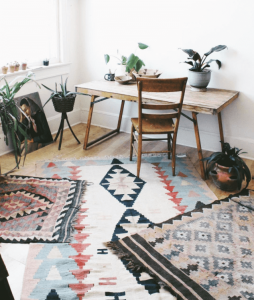
This is exactly what the more freewheeling rug layering designs try to accomplish. It’s like abstract art on your floor.
If I’m beginning to scare my more organized friends again, don’t worry. There are also ways to do this in a more orderly and geometric fashion.
Check out this page for a demonstration of just how many different ways you can go when layering rugs.
Whatever your style, the same rules apply. So let’s talk about those rules.
Complement, Don’t Compete
While layering rugs on top of each other is a relatively new trend, we’ve been arranging multiple rugs together in rooms for quite awhile now — in other words, layering within the room.
In fact, anyone who has lived in a space with an open floor plan has had experience trying to coordinate multiple rugs within view of each other.
So that should be reassuring news. Because we are guided by the same broad design principle when stacking rugs.
Generally speaking, you want to make sure your different rugs aren’t fighting each other for attention.
There are several ways to accomplish this. Consider using one or several of the following design tricks:
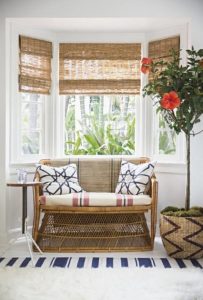
Neutral Base: Keep your base layer very neutral — maybe with a sisal or cowhide rug — and you will have greater freedom in selecting your top layer. This will purely add depth and your focus can stick to color matching only a single rug.
Different Sized Patterns Don’t be afraid to add a patterned rug for one or both layers. Just make sure that if you are incorporating multiple patterns, you use patterns of different sizes, so the overall look isn’t too busy.
Stick With One Design Style Best to keep your rugs within the same design family for a more cohesive look. For example, a lot of people have found their groove mixing Orientals, because these rugs often share the same sensibility and pattern type. HOWEVER, if you are going for a more eclectic look, ignore everything I just said. Sometimes, a room just calls for a shag mixed with a Persian rug!
Consistent Colors Choose one color that can be found in both or all of your rugs. This doesn’t mean you have to have ONLY one color. Just make sure there is a color that all the rugs have in common, even if they otherwise pull in three or four different colors. This will help you establish a more unified look.
Balance Texture Try not to go too, too heavy on texture. It’s important to find balance here, both for aesthetics and functionality. A shag on top of a chunky braided rug might just cause trips and/or tilting furniture. Ideally, one rug offers texture while the other offsets it with a smoother look.
Mix It Up
Those are, of course, just some general rules of thumb. As I mentioned earlier, some of the best arrangements come when ignoring the design rules and playing with different colors, textures, shapes and sizes. Just follow your instincts and see where they take you!
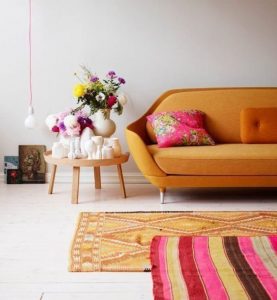
Of course, I’m always here to help if you find yourself short on time or still a bit intimidated by the process. Just give me a call and we can brainstorm together!

